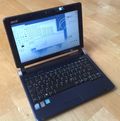 Here we go, a long weekend was ahead so I took the opportunity to finally get a netbook for myself and start experimenting with it. After some deliberation, I got an Acer Aspire One 250 with a 3 cell battery and without Bluetooth for €299. Here's my report with my first impressions, how it works with Ubuntu Linux and how easy it is to get 3G connectivity working over a 3G dongle.
Here we go, a long weekend was ahead so I took the opportunity to finally get a netbook for myself and start experimenting with it. After some deliberation, I got an Acer Aspire One 250 with a 3 cell battery and without Bluetooth for €299. Here's my report with my first impressions, how it works with Ubuntu Linux and how easy it is to get 3G connectivity working over a 3G dongle.
First, some specs. The D250 is quipped with a 10.1 inch display, a screen resolution of 1024×600 pixels, a 1.6 GHz Intel Atom processor, 1GB of RAM and a 160GB hard drive.
As I've seen on the original eeePC, Linux runs great on lower performance devices so I was keen to use Linux with this netbook as well. Unfortunately, most netbooks these days seem to be delivered with Windows XP only, so the first exercise was how to get Ubuntu installed without a CD or DVD drive.
Installation
I've seen on the net that eeeBuntu, an adaptation of Ubuntu Linux to the eeePC line of Asus supports the Acer Aspire series as well, so I decided to go for this distribution. To get eeeBuntu installed, the first step is to download the latest CD image from the web page and then install it on a USB memory stick that has a capacity of at least 1GB. Installing the image from Windows requires "unetbootin", a little tool that can be downloaded from the site as well. Once installed on the USB memory stick, the remaining procedure is pretty much straight forward as well. During a restart of the netbook, pressing the F10 key leads to the BIOS configuration menu where the boot device order can be changed to prefer USB media over the built in hard drive. The netbook then boots from the USB stick and enters the installation program. The first and crucial step is to partition the internal hard drive. To my great surprise and pleasure, it is not necessary to delete Windows from the hard drive. Instead, the Ubuntu partition manager allows to reduce the size of the Windows partition to make room for an extra partition for Linux. I evenly split the 160 GB between the two operating systems and I was up and running with both within a couple of minutes. Very nicely done, two thumbs up!
Hardware Compatibility
After booting for the first time, eeeBuntu configures itself for the hardware it finds. Most importantly, the graphics chip and the Wi-Fi were configured correctly and I could use the system right away without tweaking anything. The two devices that were not detected correctly and has since then resisted all attempts to get it working are the built in web cam and the Ethernet card. They work fine under Windows but won't do a thing under eeeBuntu. Still under investigation…
Fist impressions
 After using the system for a day now, installing and configuring the desktop and the programs as I would like to have them, I am very impressed by the speed and stability of the system. Programs such as Firefox, Gimp and Openoffice load much faster than on my full size Windows XP notebook. One of the important benchmarks for me is the somewhat power hungry Typepad web editor for my blog. It turns out that it works great on the netbook, only marking text is a bit slow. Seems to be a Firefox issue, however, as the CPU utilisation remains low. Also, the startup time of the system is impressive. After a little less than one minute, the system is up and running. As you can see on the picture on the left, I created this blog post on the netbook to get a feeling for the keyboard. It's slightly smaller than a standard keyboard but after a couple of minutes I can easly and quickly type with 10 fingers with a similar speed as on a standard size keyboard. An absolute must for me!
After using the system for a day now, installing and configuring the desktop and the programs as I would like to have them, I am very impressed by the speed and stability of the system. Programs such as Firefox, Gimp and Openoffice load much faster than on my full size Windows XP notebook. One of the important benchmarks for me is the somewhat power hungry Typepad web editor for my blog. It turns out that it works great on the netbook, only marking text is a bit slow. Seems to be a Firefox issue, however, as the CPU utilisation remains low. Also, the startup time of the system is impressive. After a little less than one minute, the system is up and running. As you can see on the picture on the left, I created this blog post on the netbook to get a feeling for the keyboard. It's slightly smaller than a standard keyboard but after a couple of minutes I can easly and quickly type with 10 fingers with a similar speed as on a standard size keyboard. An absolute must for me!
So much for this post. In part 2, I'll go into the details of how to connect to the Internet with a 3G USB dongle or mobile phone and other things I found usable or not so usable over the first couple of days. Also an important question: How happy would a normob be with Ubuntu compared to Windows XP? To be continued.


